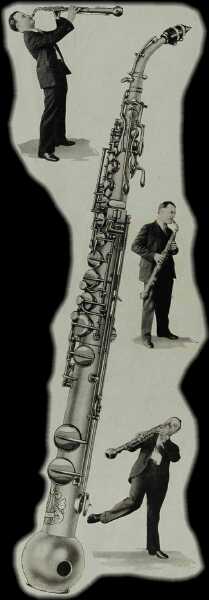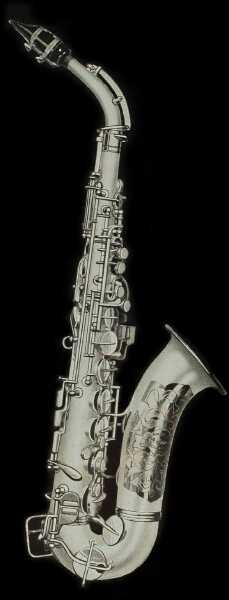 |
|
 |
|
This amazing saxophone was engineered and built by Conn to permit a player to execute the complete chromatic scale from low Bb to high F using only the right hand. To my knowledge it is a one-of-a-kind instrument, a rarity of the first order. Please consider the following attributes of this unusual collectible saxophone:
Of course executing G# is different, too, but F# down to low C is normal saxophone right hand fingerings. The remaining notes normally played by the left pinky are cleverly arranged above the right hand F-E-D touches so that your normal lower stack pads are closed when pressing low Db, B or Bb keys. The action is a bit stiff in places due to the extra springing that the player must overcome, and there are no alternate fingerings for C, Bb, Eb or F# as on a normal saxophone key layout, but the overall result is both comprehensible and completely functional. Musically, the F & G scales (C & Bb concert on an instrument keyed to F) are quite easy to master & execute. I suspect that the reason the F Mezzo Soprano design was chosen as the chassis for this instrument is connected to the ease with which the keywork could be designed to execute the nominal F/concert C scale. The sizing of the F Mezzo Soprano must also have been a consideration since it is a bit lighter & shorter than the alto. Still, an alto would have worked, though the most facile scales of nominal F & G would have been the (musically) less common and less popular Bb & Ab concert. A fingering chart is one of our exhibits, so you can compare for yourself how comprehensible an Eb scale (so a player could produce sound in concert C on the alto chassis) might be to execute relative to playing an F scale on this saxophone. Of course these considerations on playability are based on analysis by a two handed player accustomed to playing (and working on) 'normal' saxophones. If an individual has never played sax the perceptions might differ. And what if a player had lost the use of their left hand? This instrument is simply a Godsend. I suppose that's just how the one-handed musician, Al Miller (whose name is stenciled on the case and for whom it is said Conn built this instrument), perceived this very saxophone during his performing career. In the vaudeville era this was 'Six Million Dollar Man' stuff.
Aside from the brief reference to a one handed saxophone built by Conn for Miller (the type chassis is not given) on the UMI web site there is little concrete known about the origin of this instrument. In fact, it cannot be dated because it bears no serial number at all (which further strengthens the one-of-a-kind argument). Research reveals a couple mentions of one-handed saxophone designs, though. In the March/April 1990 issue of The Saxophone Journal Paul Cohen wrote that during the saxophone craze of the 1920s the Conn R&D staff had developed a design for a right-hand-only saxophone adaptable to either alto or tenor, and that Buescher had built a left-hand-only curved soprano. There is no mention of our instrument, nor of a right-hand-only Conn design for the F-Mezzo chassis, but that could be because the Conn research on one handed saxophones predated their work on the F Mezzo Soprano. Since Paul's comments are in the context of a preamble to discussing the F Mezzo Soprano model you have to assume that if he was familiar with this instrument it would have been cited. The second mention is an article devoted to this very instrument in the British publication, 'Winds', written by editor Wally Harwood ("A Curiosity in F", Spring 1989 issue). Harwood's article was based on the experiences of US collector Theodore McDowell with our instrument while it was in the hands of a Chicago repair tech & player named Don Ponce. The article speculates on the origin of this instrument in a couple ways. The first is that it was made in the late 1920s for a vaudevillian novelty act where the musician played two instruments simultaneously. The second instrument in this act is proposed to have been a trumpet or cornet, which though supported by the instrument's case configuration (see pix), seems a bit far fetched considering the complexities required to coordinate these disparate embrochures. The second explanation offered by Harwood is that the sax was built by vets returning from WWII to their jobs at the Conn factory in a program aimed at easing the reaclimation of injured servicemen. While this post WWII theory is a rather romantic notion that would make a great movie theme, the theory has a couple big holes. First, the F-Mezzo design never caught on, so the instrument was long out of production by the time WWII ended. I doubt Conn dragged the tooling back out to make just one F-Mezzo body, so to buy the post WWII theory you have to assume Conn still had a formed F-Mezzo body with no tone holes still sitting around somewhere for over 15 years. Second, this sax is the premium burnished gold finish with custom art deco engraving. While I suppose it's possible Conn made some burnished gold finish saxophones after the war, that's hard to comprehend when even satin silver saxes of that era are a bit unusual. Even more unusual would have been an art deco engraving pattern such as the one on this instrument, though the style of engraving you see here was the norm on high end 1929-30 Conn saxophones. As one Conn engraving aficionado with whom I conferred on this instrument said, this particular engraving looks like a sample sheet of Conn engravings from the art deco period. For me, the most convincing piece of evidence that supports a late 1920s build date for this instrument is the case. It's obviously a custom case made in the style of one I have in my collection that's original to a Conn transitional art deco alto of 245k s/n. The cover material, hardware & leather corner guards are exactly the same. Especially note the case handle mount when you view the picture array on this instrument. This compressed ring style of attachment was superseded with a bradded sheet metal design in the early 1930s. Inside the case there is a space for a second instrument obviously of the trumpet family. Judging by the size of that cutout for the bell outline the second instrument might even have been a flugelhorn. Regardless of the type of this second instrument, a provision for its presence certainly supports the Vaudeville novelty act theory. We can leave to the imagination whether the act consisted of a two handed musician playing both instruments at once, or a one-handed musician playing them alternately ... This very rare & unusual saxophone is sold, but please enjoy reading about it & seeing the pictures with us. |
 |
|
 |
| Main | Collection | For Sale | Hall | Gallery | Tech | Links |
|
the taxman |
|

CyberSax |